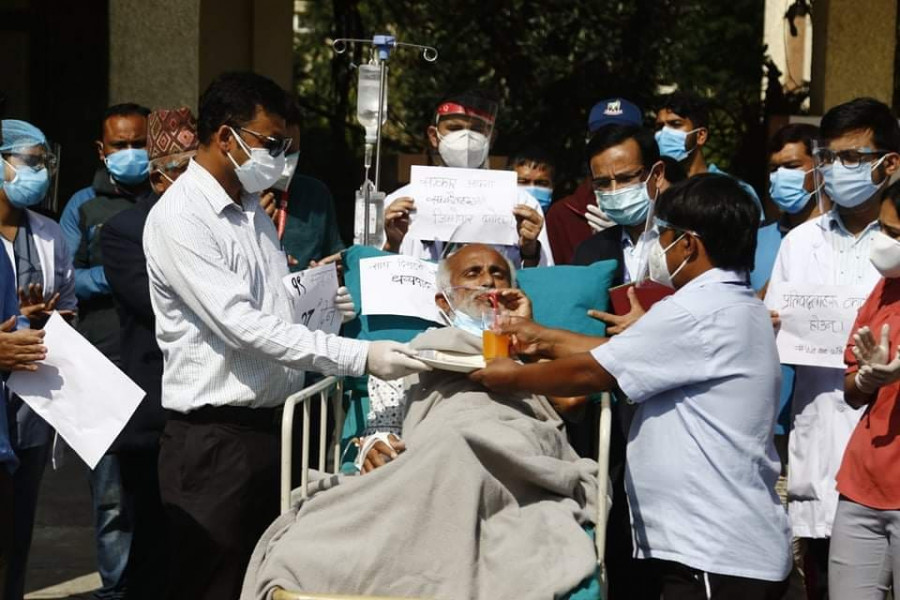National
Move to build 396 hospitals amid pandemic meets scepticism
Managing human resources will be the key challenge as a government study says 116,000 additional personnel, four times the existing provision, will be required for the proposed hospitals.
Post Report
In June Siddhartha Aauji, who cleaned toilets at Bayalpata Hospital in Achham district, set himself on fire in front of the hospital, after he was sacked, along with 32 others for lack of resources, and subsequently died of the injuries sustained. The international award-winning hospital, completed in 2019, served not only people from the district but also from several neighbouring ones.
On October 10 the government signed an eight-point agreement with Dr Govinda KC, the social crusader who has been fighting a long battle with the government for improvements in the health sector, after his 19th fast-unto-death. The third point of the agreement reads, the government will “manage the budget to provide free health services at Bayalpata Hospital”.
To date, Bayalpata hospital has received nothing from the federal government.
“The federal government has not yet announced the allotment of budget to the hospital even after signing an agreement with Dr KC," said Dr Bikash Gauchan, healthcare director at the hospital. "The hospital already has enough problems due to fund shortage including shortage of emergency medicines. The funds from the centre would at least give us some respite in operating the facility smoothly."
The federal government on Sunday, on the other hand, laid the foundations, amidst much fanfare, of 396 five to 15-bed hospitals across the country. Foreign Minister Pradeep Gyawali called the government move a “revolution”.
Some have welcomed the move and are hopeful of a future with easy access to health services.
“No one in our village will now die for want of treatment and delay in reaching the hospital,” said Saraswoti Bhattarai, a resident of ward 11 in Shuklagandaki Municipality in Tanahun, where foundation was laid for a new hospital. “We now have to go to Putalibazar in Syangja or Pokhara for treatment even for minor illnesses. Establishing a hospital here will save us the trouble.”
But generally, observers have scoffed at the move.
“This is nothing more than another political stunt to divert attention of the public, who have been affected by the coronavirus pandemic,” Dr Govinda Ojha, former director general at the Department of Health Services, told the Post.
Across the country, health workers are equally sceptical and doubt if the building of hospitals will amount to much in the long run.
On Monday the foundation stone for a 15-bed hospital was laid in Belbari Municipality of Morang district. But close by a primary health centre has been shut since the post of a medical doctor is yet to be filled.
The situation of 18 hospitals and 41 primary health centres in Province 1 is similar.
At Biratnagar-based Koshi Hospital, as many as 27 posts of consultant doctors and 12 posts of staff nurses are currently vacant. The hospital is struggling to provide health services due to the shortage of human resources and equipment.
“It is easier to construct physical infrastructures and buy equipment but it is difficult to manage medical staff,” said Sital Yadav, a retired doctor based in Morang. “It would have been wiser to arrange for required human resources and tools before going on a spree of building new hospitals. The new hospitals will also face the same ordeal—shortage of human resources.”
Narayani Hospital in Birgunj, one of the country’s oldest hospitals, is similarly short-staffed. Of the total 193 posts of employees, 44 are vacant.
“We have been asking for the government’s support to increase the number of beds from 200 to 500 since the number of patients visiting the hospital has increased over the years. But nothing has been done yet,” said Dr Atulesh Kumar Chaurasiya, the spokesperson of the hospital.
“Basic health care is not only the buildings,” said Ojha, the former director general of the Department of Health Services.
It is not only in the remote areas of the country that health workers are lacking.
Due to apathy to hire health workers, including doctors and nurses, Bir Hospital in Kathmandu has been unable to fully run buildings constructed and handed over by the Japan International Cooperation Agency some 18 months ago.
At present there are 30,000 positions for health workers in government health institutions but only 27,000 of them have been filled, according to the Health Ministry.
An organisation and management survey carried out by the Health Ministry estimated that over 116,000 additional personnel including doctors, nurses, paramedics, lab technicians and administrative staff are needed for the new hospitals whose foundation stones were laid Monday.
In Gandaki Province, health professionals are worried about managing human resources for the new hospitals. Keshav Adhikari, vice chairperson of the Nepal Public Health Association in Gandaki Province, is doubtful that the new hospitals will be able to sustain in the absence of required medical infrastructure and human resources.
In Lumbini Province, foundation stones were laid for 57 hospitals on Monday. But the move received a lukewarm welcome from health workers since most of the existing health facilities have become referral centres.
“There is only 60 percent of human resources in hospitals in the province. Most of them also lack physical infrastructures,” said Dr Binod Kumar Giri, director of the Health Directorate of Lumbini Province. “Most of the hospitals are turning into referral centres since they are not armed to deal with critical cases.”
According to the Provincial Health Directorate of Karnali Province, out of the 800 posts of health workers in the province, only 296 posts are currently filled.
Similarly, according to the Provincial Health Directorate of Sudurpaschim Province there are a total of 454 posts of doctors in 13 hospitals but 183 of them remain vacant.
The building spree comes at a time when the federal government is reluctant to spend money to contain the spread of the ongoing pandemic when contact tracing has stopped leaving people to die avoidable deaths.
Due to the Health Ministry’s suggestions to seek treatment only after suffering from breathing problems or falling unconsciousness, patients are waiting at home without undergoing tests and reaching hospitals too late if at all.
“The government does not have money to save lives but has sufficient funds for construction of hundreds of buildings,” said Ojha.
The bill for the new construction is expected to be Rs57.95 billion.
Former Health Minister Gagan Kumar Thapa agrees with Ojhा. He called the start of the construction of basic health care facilities at local levels a good initiative, but wrong in terms of priority.
“The major priority of the government should have been saving lives at present,” Thapa told the Post. “How can the lives of the infected patients be saved by starting construction of the hospital buildings?”
“In the public health, it is called the unethical allocation of resources,” Dr Baburam Maraasini, former director at the Epidemiology and Disease Control Division, told the Post.
(With inputs from our local correspondents.)




 7.12°C Kathmandu
7.12°C Kathmandu


%20(1).jpg&w=200&height=120)











